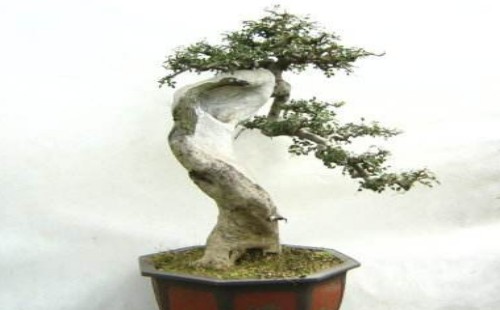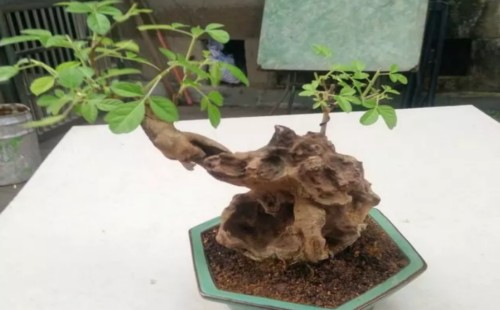How to graft tree stump rose
Rose is a kind of tufted shrub with no obvious trunk, and in order to cultivate rose bonsai with stump characteristics, it is often necessary to adopt grafting means. The stump that can be used for grafting rose mostly uses rose as rootstock, at the same time, rootstock is required to grow healthily, root system is developed and there are no diseases and insect pests. The tree stump rose cultivated on this basis is often more ornamental after it is made into bonsai.

And if rose stump is used as rootstock to graft rose, many varieties of rose can be grafted on the same old pile at the same time, making rose bonsai blossom larger, more colorful, branches and leaves more luxuriant, and florescence longer, so it is more durable than ordinary rose bonsai, both ornamental value and economic benefits are often higher. So, how to graft the tree stump rose?
First, select rootstocks
Making stump bonsai by grafting is first of all very important to the selection of rootstocks. Because the stump rose bonsai requires well-developed root system, stout trunk, round crown, numerous branches and colorful flowers, and the sturdy rootstock should not only be able to support the whole crown, but also have sufficient ability to supply nutrients, which is the key to the success of grafting. At present, the most suitable and widely used rootstock is the old pile of Rosa, and the American thornless rose and Japanese thornless rose are the two most widely used rootstocks.
Second, make scion
In order to cultivate high-quality stump rose bonsai by grafting, we should not only choose a good rootstock, but also require us to produce a high-quality scion. In order to produce high-quality scions, it is often necessary to meet two conditions: one is that the scion varieties have strong growth advantages and the ability to germinate branches in order to form a round crown in the later stage; the other condition is that the characteristics of the scion should be as close as possible to the selected rootstock, which can not only inherit the advantages, but also more conducive to the survival of grafting.
III. Timing of grafting
The grafting time of tree stump rose is often determined according to the temperature environment, grafting materials and grafting methods, especially the original is greatly affected by the temperature environment. Due to the vast territory of our country, the temperature difference between the north and the south varies greatly, usually the four seasons are not very obvious in the south, while the four seasons are often distinct in the north, so the temperature environment varies with different regions. However, the grafting process often requires the local temperature to be suitable and stable, so it is necessary to choose an appropriate time for grafting, especially to avoid grafting when the temperature fluctuates too much in a short period of time. It is generally suitable for spring grafting in the south of China and autumn grafting in the north of China. But it still has to be considered according to the local situation.
IV. Preparation for grafting
In addition to grafting, we must make preparations in advance, especially all possible tools, such as paper cutters, special branch scissors, grafting knives, grafting belts, and so on. The grafting work generally needs to be carried out when the nutrient accumulation of the rootstock and scion is the most abundant, because in this case, both the rootstock and the scion are in an energetic and ready state. If the temperature and humidity are more suitable, the survival rate of grafting will be higher.
5. Grafting process
The grafting of rose stump is generally realized by sticking buds, first of all, cut the rootstock on the main branch of the rootstock, the cut depth is just enough to see the woody part, and the size of the incision should be consistent with the size of the scion bud. Because the two are not coordinated, there may be insufficient fit, not close under your high, it is easy to lead to grafting failure. Then cut 1-2 cm long buds on the scion, attach a little woody composition to the lower end, then stick it tightly to the grafting interface of the rootstock, let the cambium align with each other, and finally wrap the grafted part with a grafting belt.
VI. Maintenance and management
After the completion of the grafting activities, the following maintenance and management work is also very important. Because the buds in the grafting process have not been integrated with the rootstocks, and the leaf buds of the rootstocks will sprout in large quantities, which will inevitably consume a lot of nutrients, thus reducing the survival effect of the buds, weakening their growth, and may even lead to the death of the buds. Therefore, during this period, we can not allow it to grow wildly, we need to wipe off the new buds on the rootstock in time, and we also need to do a good job in the prevention and control of diseases and insect pests on the rootstock. Through careful maintenance, if it goes well, the tender green buds can be seen on the buds in about a month, and the healing tissue will grow gradually, and the grafting work will be basically successful.
Time: 2019-06-06 Click:
- Prev

Preliminary shaping of tree stump bonsai
Tree stump bonsai often adopts different modeling techniques due to different tree species, and the effect of bonsai produced is also very different. Although the modeling techniques are different, the bonsai produced by the tree stump will have their own advantages due to their different shapes. However, before making tree stump bonsai, we first need to dig up the stump landscape.
- Next

How to water the bauhinia bonsai in the initial stage
Bauhinia is a kind of tree species with extremely tenacious vitality, which is not only lax to the soil environment, but also has a strong ability to adapt to the environment, so it is widely distributed in China. As the bauhinia is relatively easy to shape, especially the old stump looks old, but the leaves are very bright green, the two form a sharp contrast
Related
- Fuxing push coffee new agricultural production and marketing class: lack of small-scale processing plants
- Jujube rice field leisure farm deep ploughing Yilan for five years to create a space for organic food and play
- Nongyu Farm-A trial of organic papaya for brave women with advanced technology
- Four points for attention in the prevention and control of diseases and insect pests of edible fungi
- How to add nutrient solution to Edible Fungi
- Is there any good way to control edible fungus mites?
- Open Inoculation Technology of Edible Fungi
- Is there any clever way to use fertilizer for edible fungus in winter?
- What agents are used to kill the pathogens of edible fungi in the mushroom shed?
- Rapid drying of Edible Fungi

